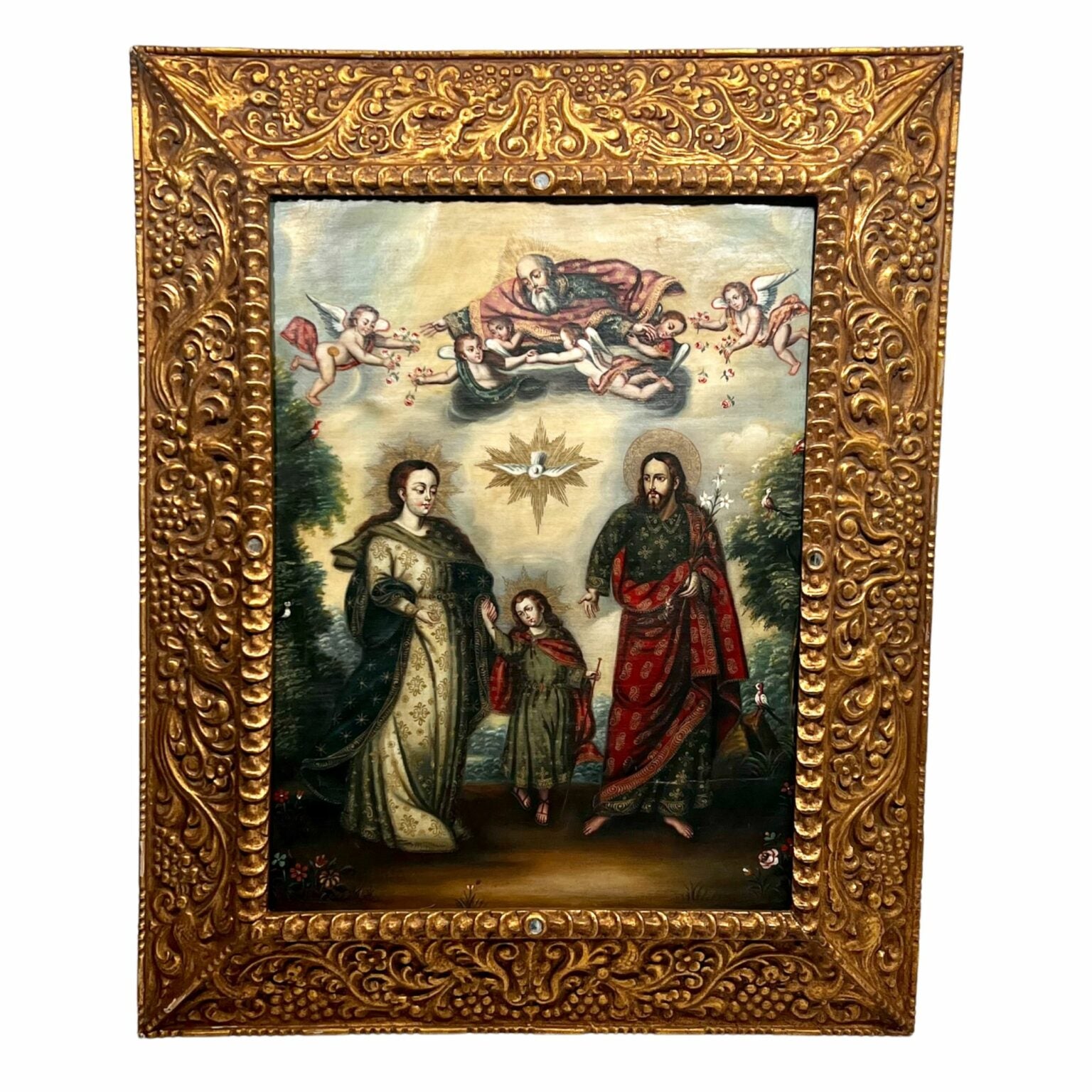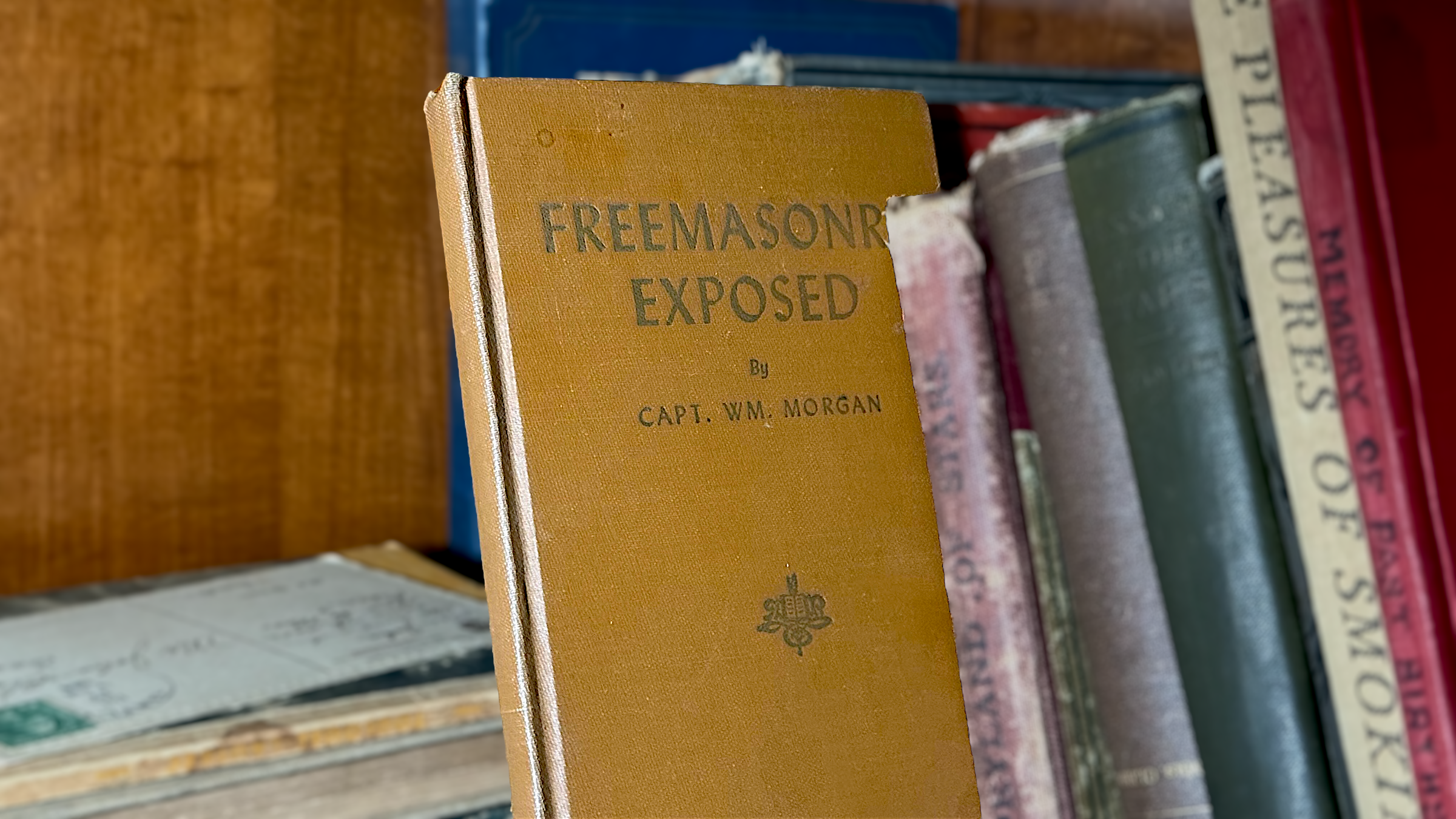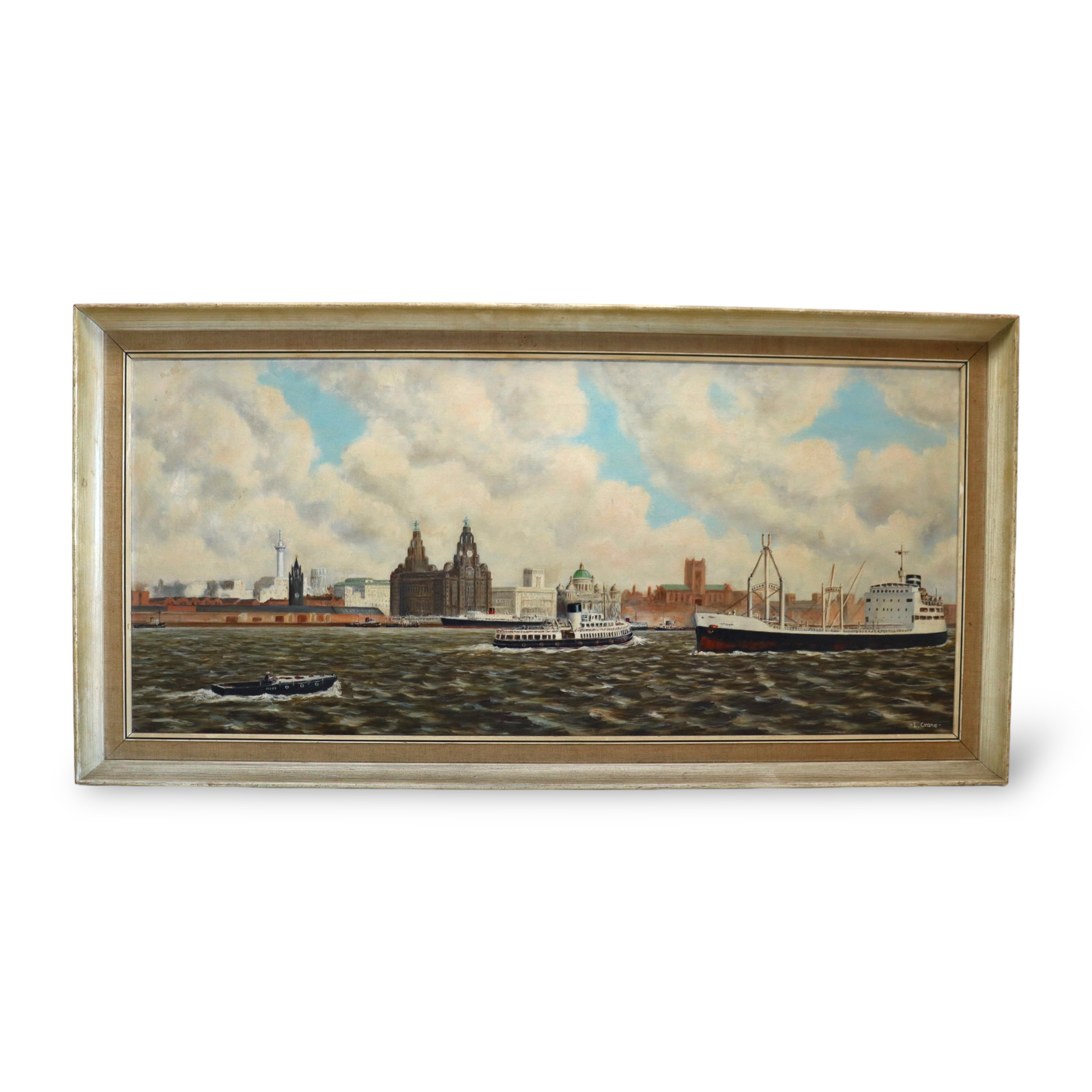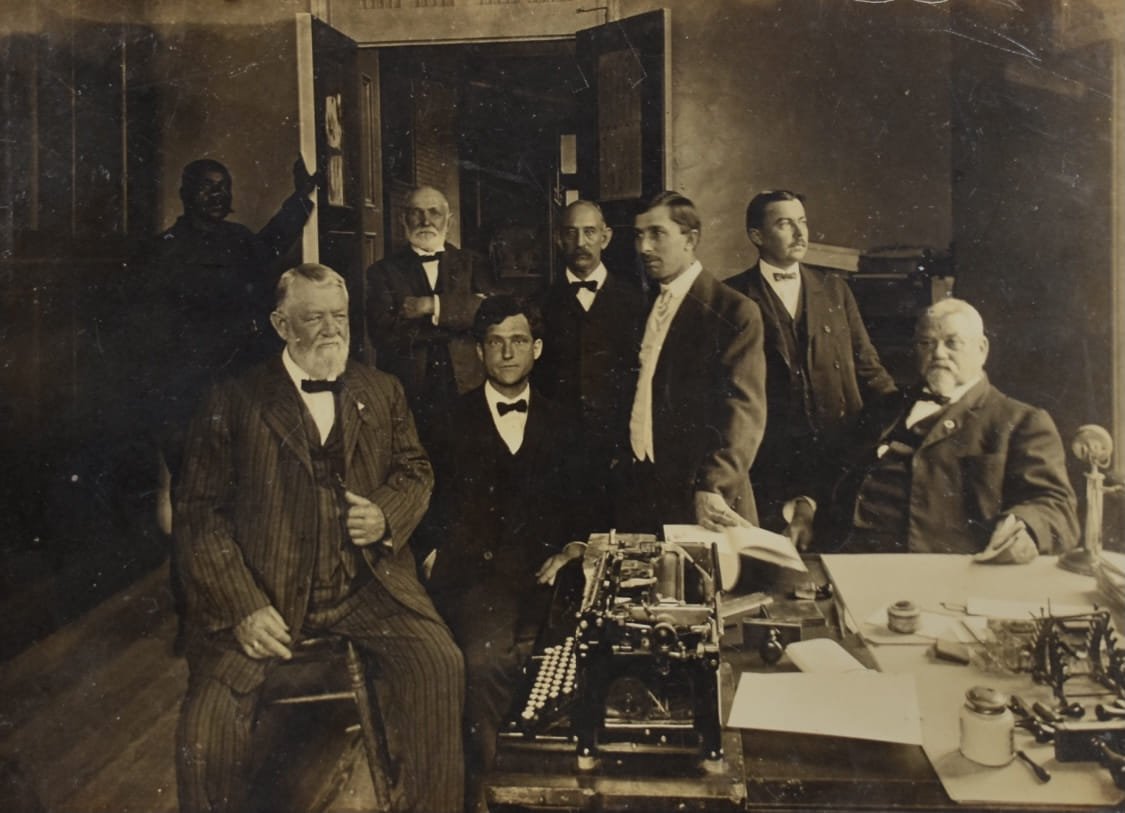Exploring the Religious Symbolism in a Late 18th-Century Spanish Colonial Painting
Religious art has long served as a bridge between the earthly and the divine, offering believers and art enthusiasts a profound glimpse into spiritual truths through visual storytelling. This late 18th-century Spanish Colonial painting—depicting the Holy Trinity alongside the Holy Family. Is an exceptional example of such artistry. With its intricate symbolism, masterful composition, and rich theological motifs. The painting invites viewers to reflect on themes of faith, love, and divine connection.
The Centerpiece: The Holy Family and Holy Trinity
At the heart of the painting is a harmonious depiction of the Holy Family: Mary, Joseph, and the child Jesus. Surrounding them is the Holy Trinity, represented by God the Father, Jesus Christ, and the Holy Spirit, shown as a radiant dove. The inclusion of both the Holy Family and Holy Trinity creates a powerful visual narrative, uniting the divine and earthly realms.
God the Father is depicted above the family, gazing lovingly downward, his triangular halo symbolizing the eternal unity of the Trinity. The dove, representing the Holy Spirit, radiates light and serves as a spiritual connection between heaven and earth. This central composition emphasizes the theological concept of God’s presence within the family unit. Highlighting the divine nature of Christ’s mission on earth.

The Symbolism of Joseph and Mary
Joseph is shown holding a lily, a traditional symbol of purity and righteousness. This motif underscores his role as the protector of Mary and Jesus, as well as his steadfast faith in God’s plan. The lily’s delicate yet resilient nature mirrors Joseph’s quiet strength and devotion.
Mary is adorned in richly detailed robes, her serene expression radiating grace and maternal love. Her proximity to Jesus emphasizes her role as the Mother of God and an intercessor for humanity. The rose-like patterning on her garments subtly references her connection to the Rosary, a cornerstone of Catholic devotion.


The Presence of Cherubs and Angels
Above the Holy Family, cherubs and angels scatter roses and look on in adoration. These celestial figures symbolize divine blessings and serve as intermediaries between the mortal and divine realms. The roses they scatter carry rich meaning; in Catholic tradition. They represent prayers offered to God, devotion to the Virgin Mary, and the beauty of spiritual sacrifice.
The cherubs’ joyful expressions and dynamic positioning create a sense of heavenly celebration, reminding viewers of the joy that the Holy Family’s presence brings to both heaven and earth. Their inclusion reinforces the painting’s role as a devotional piece, inspiring contemplation and reverence.

The Divine Star: Bridging Heaven and Earth
Central to the composition is a radiant star, a powerful symbol of divine guidance and connection. Positioned between the Holy Trinity and the Holy Family, the star evokes the Star of Bethlehem, which led the Wise Men to the newborn Jesus. Its placement underscores the idea of God’s guiding presence in human life, linking the events of Christ’s birth to his role as the Savior of humanity.
The Pastoral Landscape and Earthly Connection
The serene landscape in the background, complete with local birds and natural elements, adds a touch of earthly tranquility to the composition. This pastoral setting serves as a reminder of the interconnectedness of creation and the divine order of the universe. The birds, often seen as symbols of freedom and the soul, complement the painting’s themes of spiritual elevation and divine harmony.
The Frame: A Sacred Encapsulation
The painting’s hand-carved gilded frame, adorned with beveled mirrors, is not merely a decorative element but an extension of the artwork’s symbolism. The use of gold leaf represents divinity, purity, and the transcendence of earthly concerns. The mirrors, reflecting light and the surrounding environment, invite viewers to see themselves within the sacred narrative, encouraging self-reflection and spiritual contemplation.
Such elaborate frames were hallmarks of Spanish Colonial religious art. Often designed to enhance the visual impact and devotional significance of the piece. In this case, the frame’s intricate details and luminous quality elevate the painting, making it a focal point for worship and admiration.


Exploring Numerological Insights
Even the dimensions of the painting carry symbolic resonance. The frame measures 42 inches tall by 34 inches wide, while the canvas itself is 22 inches wide by 30 inches tall. In numerology, the number 42 symbolizes stability and harmony, reflecting the balanced composition of the artwork. The number 34 reduces to 7, a number often associated with spirituality and divine insight.
Similarly, the canvas dimensions offer deeper meaning. The number 22, considered a master number, signifies spiritual mastery and vision, while the number 30 represents creativity and optimism. These numerical associations add an additional layer of intrigue and spiritual depth to the painting.
Theological Themes: Love, Sacrifice, and Redemption
The painting’s intricate details and composition are imbued with themes central to Christian theology. The unity of the Holy Family mirrors the ideal of familial love and devotion, while the presence of the Holy Trinity. Emphasizes the interconnectedness of the divine and mortal realms. The scattering of roses by cherubs symbolizes the sacrifices and prayers that form the foundation of Christian life.
Moreover, the juxtaposition of divine figures and earthly elements underscores the idea of Christ as the bridge between heaven and earth. This duality is central to the Christian narrative, reflecting both the divinity of Christ and his humanity.

A Masterpiece of Spanish Colonial Art
This late 18th-century painting is a quintessential example of Spanish Colonial religious art, blending European artistic traditions with local cultural influences. Its rich symbolism, exquisite craftsmanship, and devotional intent make it a valuable piece of religious and artistic heritage. Such paintings were often commissioned for churches, monasteries, or private chapels. Serving as visual catechisms that taught theological concepts through imagery.
The painting’s intricate composition and attention to detail highlight the skill and devotion of the artist. Whose work continues to inspire and uplift viewers centuries later. Its preservation and beauty make it a treasure not only for collectors but also for anyone seeking a deeper connection to faith and history.
The Future Value: An Investment in Art and Faith
Religious art, particularly from the Spanish Colonial era, holds immense appeal for collectors and investors alike. This painting’s rich symbolism, historical significance, and exceptional craftsmanship make it a valuable asset in the art market. As interest in culturally and spiritually significant works continues to grow, pieces like this are likely to appreciate in value over time.
The rarity of such paintings, coupled with their connection to an important historical period. Positions this artwork as both a cultural treasure and a sound investment. Collectors who acquire it are not just purchasing a decorative piece; they are safeguarding a legacy of faith, artistry, and history that will resonate with future generations. The painting’s enduring beauty and spiritual depth ensure that it will remain a sought-after centerpiece in any collection.
Conclusion: A Portal to the Divine
This late 18th-century Spanish Colonial painting is more than an artwork; it is a testament to the enduring power of religious art to convey profound spiritual truths. From its depiction of the Holy Family and Holy Trinity to its layers of symbolism and intricate craftsmanship. The painting invites viewers to reflect on the mysteries of faith and the beauty of divine love.
Whether admired for its artistic merit, its theological depth, or its historical significance. This painting stands as a beacon of devotion and a celebration of the interconnectedness of heaven and earth. It serves as a reminder of the timeless relevance of religious art in inspiring contemplation, reverence, and a deeper appreciation of the divine.











